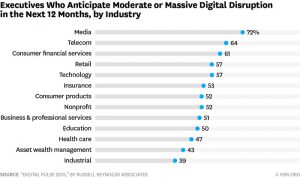Digital Transformation Strategy Redefined
How to catch up new horizons of business surface when it’s so supple and liquid? Simple! Build a digital transformation strategy that is as dynamic as the business itself.
At this very moment if business wants to win the attention of more than 80% of perspective customers, or close to 95% if we are talking B2B, one needs to go digital. The list of the industries that will adopt fundamental digital transformation is impressive, isn’t it?

Image Credit: Russell Reynolds Associates
In view of these changes some claim a digital strategy dead, while we call it a phoenix, for it will be reborn into a Digital Transformation Strategy 2.0, fully adjusted to dynamic business ecosystems of these days.
Digital Transformation Strategy 1.0

A classic digital strategy as we know it is far more than over-formulated Wiki-like descriptions or common yet one-legged definitions that touch upon only IT or social media.
We see a classic digital transformation strategy as the blend of technologies into daily business activities that becomes the essence of a business strategy, rather than one of its parts.
That’s right, the essence. A digital transformation strategy organically digests IT and marketing strategies and makes them work as tech and coordinative parts of its organism. This organism, in its turn, becomes a nucleus of any company’s business strategy.
Let’s make it simple. Look at a couple of examples to see a classic digital transformation strategy in action:
Think of Oxford Dictionaries project that grounds its ambitious initiative to create living dictionaries for under-represented languages in its digital approach. The Dictionaries Conversion Framework (DCF) created by Digiteum became the digital core of this project. This one-box solution for any language made it possible in the first place, and efficient in the second (think of conversion time shrunk from 3 months to 1 week). Not only did the platform contribute to the project, but shaped its strategy and empowered its movement from plan to action.
This is the other example that shows how make-up changes that might have looked like a digital strategy turned out to be a digital tragedy instead.
Heard of Kodak? These guys invested millions into their aggressive marketing campaign with a former Apple consultant on the side and all bases covered. However, their campaign of building a “digital brand” have never turned into a digital strategy, since the way they worked remained “analog.” As a result, they ended up with major losses because their approach appeared outward and rootless.
On the brink of 2017 we consider a classic version of digital transformation strategy as solid state physics. Its basics always remain as laws, but the heavy hitters keep going quantum for more opportunities.
Digital Transformation Strategy 2.0
A solid digital transformation strategy doesn’t fit agile business environment; it should be replaced with something more liquid. This is how Digital Transformation Strategy 2.0 breaks out and contributes to business growth anew. The thing is, the climate of business today determines agility as stability. This is why a digital transformation strategy today is seen as a process focused on improving business rather than simple imbedding of new technologies.
How Digital Strategy 2.0 empowers business growth
- Unite forces. Business brings more when different departments like IT and marketing collaborate.
Think of PicCities project that blended marketing with IT and managed to increase customer engagement dramatically by installing an iOS application. Eventually, it brought the company the revenue that marketing activities alone might never get.
- Get cost-efficient. Real-time decision-making and development built on small split up goals let businesses leverage expenses and get faster results at lower costs.
Do you know how much you need to develop a simple chatbot? It won’t cost you more than $10k-$15k to automate customer service and cover the needs of your business in B2C communication and social activity.
Business Growth Digital Strategy
When businesses invest massively to go digital, often it’s a digital transformation strategy that helps to build foundation for business growth. Therefore, business strategy today stems from a digital strategy.

Image Credit: Pixabay.com
4 wins of Digital Transformation Strategy 2.0 (DTS 2.0) that make business strategy work
- DTS 2.0 treats time anew, it values time more. This is why a business strategy based on such digital strategy cuts the losses caused by wasted time.
- DTS 2.0 turns into a process and brings agility and better response for changing requirements in software development – some of the most important assets of every business today.
- DTS 2.0 is tuned to multi-channels, so it allows greater customer engagement and business upscaling.
- DTS 2.0 converts competition into a fair play, since the role or business size neutralizes when digitization comes in.
Read: Key takeaways from our Meetup on IT outsourcing
Digital strategy consulting kickstarts transformation
Digital strategy consulting is an integral part of a new approach in building a strategy. Moreover, consulting becomes an organic part of a digital transformation strategy from the moment it is formed as an idea to the point when it brings tangible results and moves businesses to the new loops of growth.
On the one hand, a smart digital strategist is constantly combing the flow of novel technologies to pull out the ones matching the business strategy that the company has. On the other hand, consulting helps to shape a future digital strategy and impacts the business strategy of the company in tune with the trends of digital transformation in its field.
Look at Printique* case as an example. Today it’s one of the printing industry leaders on the U.S. market that manages terabytes of graphical content per month. Digiteum has been acting as a digital consultant and solution provider for over 6 years already and keeps on building an ongoing digital transformation strategy for the company today. Results show how this cooperation lets Printique upscale its business significantly and move to a brand new level of growth.
All in all, the shift from a digital strategy to a business growth digital strategy is visible. It has already started influencing the way businesses make decisions and take action. In this regard, the use of digital strategy consulting as professional support also transforms from bon ton to an essential tool for building a business growth strategy anew.
At Digiteum we are crazy about digital. We think digital, talk digital (but not with digital voice). We leverage our development services expertise and help brands develop and implement their digital transformation strategies. Do you have questions? Start a conversation now.
*Formerly AdoramaPix
This is an updated abridged post, the original article was published at IT.TMCnet.




